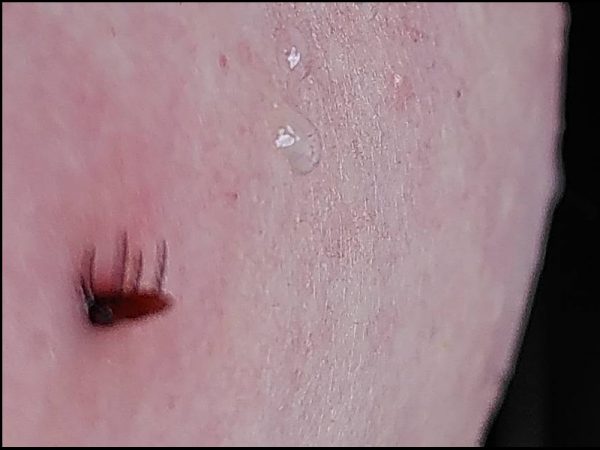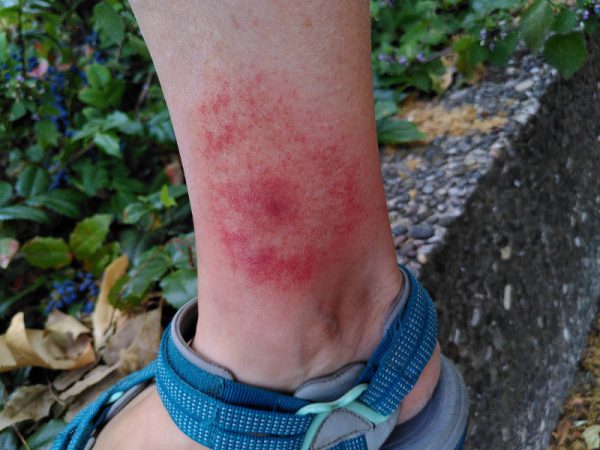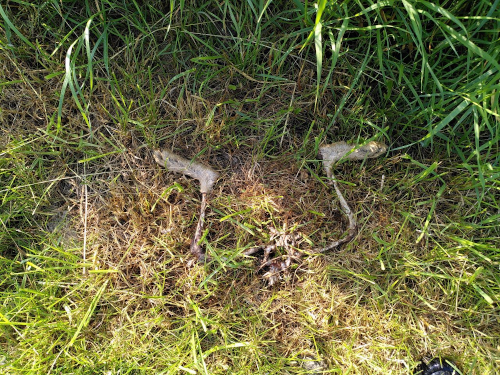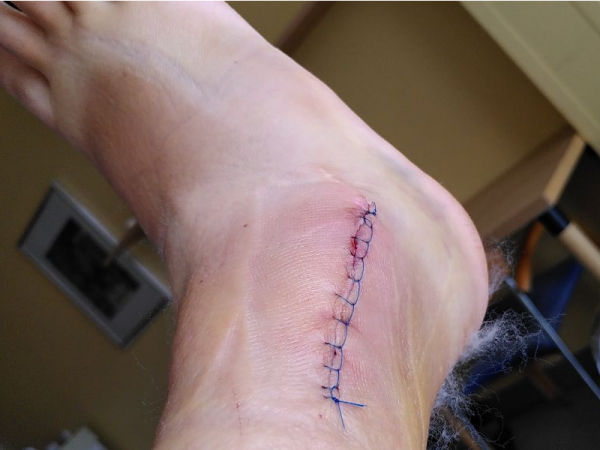Making Women Characters suffer on Television
Warning: this text is about, among other things, violence against women portrayed on television.
Warning: some of the photographs used may cause unpleasant feelings.
I recently read the appeal by Liz Tucker, Chair of Women in Film and Television UK, on the issue of violence against women in fictional programs. It began with the question “Why do so many shows feature violence against women?” – which goes with two older texts of mine, one published, one unpublished, which I will present today.
WFTV UK is asking Why?
Liz Tucker published the following on 1 November (You can find the full text on the WFTV UK website and on Broadcast Now, emphasis in the quote by me):
Every night of the week across a wide range of broadcast platforms, if I so wish, I can watch stories about women being raped, decapitated and murdered in ever more imaginative and gruesome ways. As it happens, I don’t wish, because I think the time has come for all of us working in the broadcast industry to think much more carefully about the message we are sending out when we continually produce TV crime dramas and documentaries that have women as the central victims. Recent years have seen an avalanche in this type of programming and there seems to be a spiralling competition between some writers and directors to escalate the violence and come up with ever more graphic and disturbing ways to portray the murder of women. (…) Would it really be so hard today to come up with imaginative new plots that don’t involve the brutalisation and murder of women?
No. Of course not. It just has to be wanted.
Part 1 and 2 of the Trilogy
In Germany it looks similar – yes, I would even say worse, because my impression is that in our country violence is less implied but shown more clearly and drastically, in an unpleasant way, through men’s glasses (think “male gaze”).
On February 12, 20 my blog text #morethancorpses – TV Cop Dramas – Actresses can do more than play Victims was published:
German television is known to be quite crime-oriented. More and more formats, series and individual films of this genre are being produced, and it‘s increasingly rare that they get by without staging brutal murders and corpses in close-ups. However, it is possible to tell a thrilling and entertaining crime drama in a different way, and this is why I want to give the example of a Swedish mini-series, as counterbalance to the films that begin with a brutal rape or the discovery of a young, pretty, abused, dead woman. Actresses can do more than play victims.
Here, among other things, I am discussing the different visual approaches in examples from German and British crime thrillers and crime series. Taking a Shower from 3.3.17 also fits into this context:
Last weekend I watched four films and each contained a scene where a woman took a shower. Only women, no men. This may be a coincidence of course. But moving on from there, what is it with showers and films, is a character taking a shower a stylistic device, a dramaturgical trick? Is taking a shower for a film today what cigarettes or alcoholic drinks used to be in former years? Are shower scenes about showing nakedness, cleanliness, vulnerability? Or about erotics? Are showers extremely challenging film locations or extremely appealing and exciting settings?
I wrote most of the following text a year and a half ago but did not finish or publish it. With greetings to Kim Seidler, to whom I announced it as “coming soon”, here it is:
Part 3: Tortured Women in Close-Ups
The other day I was interviewed by journalist / author / dramaturge Gisela Wehrl for the magazine AUSLÖSER. She asked me, among other things, if there was another unpleasant pattern besides the beautiful young naked female corpse (#morethancorpses) that I keep encountering on German television, especially in German television crime films. I replied that I had noticed several films in which so-called “strong women” (specifically: female coppers) had to experience physical violence up to and including attempted murder. And that images of these terrible experiences were often appearing on social media.
TV Crime Dramas Festival 2020, two competition films. The Dresden Tatort (German top cop drama) DAS NEST (script Erol Yesilkaya, first broadcast 28.4.19). This is about a murderer who “deliberately bleeds his victims to death in order to then preserve the corpses and group them stuffed into family scenes” (source Wikipedia). Why he does this is lost in the course of the 90 minutes, I don’t recall it being cleared up or even mentioned again. In any case, Detective Sergeant Karin Gorniak (Karin Hanczewski) is also attacked by the murderer (Benjamin Sadler), he stuns her son after he – how, actually? – had gained access to her flat without any problems. And he stuns her too, takes her to his house in the basement and starts bleeding her out too. This is shown thoroughly, again and again we see the bound woman tied to a table, her eyes widened in agony, the bag filling with her blood. It looked like considerably more than a blood donation of 450 to 500 ml, maybe a litre? The camera (Carlo Bobby Jelavic) follows the perpetrator’s gaze on Gorniak or shows what is happening from the outside, I don’t remember Gorniak’s perspective, her gaze on the perpetrator. She is able to defend herself in the end, despite immense blood loss, and lives.
The second film was the Rostock Polizeiruf 110 DER TAG WIRD KOMMEN (script Florian Oeller, first broadcast 14.6.20). Here, right at the beginning, Detective Chief Inspector Katrin König (Anneke Kim Sarnau) is beaten up when she tries to protect a woman who is being harassed by two men. In addition, she is tormented quasi-remotely by a convicted felon (Peter Trabner) whom she put in prison with manipulated evidence after another murder could not be proven against him. Someone (an ex-con (Björn Meyer) who works as a caretaker in König’s apartment building of all places – and has keys to all the flats? I didn’t understand that) manipulates medicines and ointments in König’s bathroom on his behalf, which he somehow knows about? and the use of which subsequently puts her into a psychotic state. Also shown very extensively. The strong woman who is down on the ground. Twice.
Drastic image, description
A blonde woman stands facing the camera, her gaze goes into the distance. Pressed close to her is a man who puts his left hand on her shoulder, with his right hand he presses a knife to her throat.
A dark blond woman seems to be kneeling on the floor, we see her almost in profile. Her gaze is fixed on a hand pointing a pistol at her head from an angle above.
The dark blonde woman is sitting on a chair, her hands are tied behind the backrest. We see her in profile. Opposite her at a distance of perhaps 1.5 m is a bald man who is baring his teeth and pointing a gun at her chest with his arm outstretched. In the background between them, a black-haired man sits on the floor watching her.
Like the abused women mentioned earlier, these characters are also commissioners: Charlotte Lindholm (Maria Furtwängler) in the Göttingen TATORT KRIEG IM KOPF (script Christian Jeltsch, first broadcast 29.3.20) and Sonja Schwarz (Chiara Schoras) in the Bolzano crime thriller BLUTRACHE (script Thorsten Näter, first broadcast 2.4.20). They are not only scenes from the crime thrillers, but motifs that were used as PR by the broadcaster and posted on social networks, also by those involved. Without warning.
More audience through “Sex Sells” and “Violence against Women Sells”?
There are a few such pictures on social media. Between photos of cats, shoes, food, radiant people and beaches, there it is, suddenly a picture of a woman with a knife to her neck. A threatened woman. A woman covered in blood. A man attacking a woman (with the hashtags #newproject #itsfun). It’s just fiction, after all, film stills or some from the shoot. And they are on the channels of actors, production companies or broadcasters, so it should be obvious, just pictures of work. But is it always immediately clear to us, or do we first react emotionally to what is depicted, to the threatening situation? Are we shocked, agitated, or is this already so normal in German thrillers that it no longer touches you anyone?
They say that there are always fierce audience reactions and letters when, for example, dogs are killed in a cop drama. But not when it comes to violence against women, against main characters? Too normal? Strong woman, protagonist, audience favourite, idol – in her face?
I don’t understand the decision behind sacrificing the main female character of a series in this way. Shouldn’t she inspire us, shouldn’t we sympathise with her, maybe even identify with her? Well, and then she is bled, poisoned, beaten, threatened, tortured. So that we see that in reality she is not so strong and successful and independent. They are apparently – as the examples from Dresden and Rostock show – not even able to secure their flats properly against criminals who enter without any difficulty with their criminal doings (drugging the son of one of them along with threatening and kidnapping, as well as slowly poisoning the other). And then one of them also has bad luck with her uncomprehending and insensitive superior, but that’s another topic.
One question: are there similar experiences for the male colleagues? I can’t think of any, but that doesn’t mean anything, there are so many crime dramas on German television that it’s not possible or even desirable to watch them all. If you can think of any examples, please feel free to write to me. Thank you!
A man is frightened
Oh yes, there is a scene in the crime novel SÖRENSEN HAT ANGST / Sörensen is frightened (screenplay and novel by Sven Stricker) in which the title character, a commissioner, has a gun held to his temple. But that didn’t really seem threatening to me. For one thing, Sörensen (Bjarne Mädel) rolled his eyes really extremely to the side, almost like in a comedy. And besides, this short scene dissolved very quickly, because the gun was not loaded, the threatener, if I remember correctly, a slightly confused alcoholic. In any case, it didn’t resonate with me for long, just as the story of the character Sörensen didn’t really touch me either. The basic story is that he suffers from an anxiety disorder, so he had himself transferred from the big city to Friesland, and then is a kind of lonely investigator. But I only got the anxiety disorder because Sörensen lectures his new and basically unknown colleague (or another woman, I can’t remember exactly) about it. Nevertheless, the photo, which was often used for PR for the film and to underline the title, can have an unsettling effect on viewers.
And that leads me to the question of why there are so few warnings about violent crime films on German television and why broadcasters or actors / actresses share these pictures on their channels without a trigger warning – which would be very possible on Instagram, for example: a bar with TRIGGER WARNING! could be edited over the photo, and below it, as a second picture, one without a warning.
Leaving the series
Finally, I would like to address the phenomenon of the so-called TV series death. This does not mean that a series ends gracefully or brutally, but that a character in the script dies and thus leaves the series.
There are no limits to the creativity of how a character is written out of the series; for example, he or she could simply be transferred to another city, take early retirement, take on the domestic care of close relatives, go on a trip around the world, go to prison for bribery, change jobs, get married and become a househusband/wife, and so on. There are many possibilities. The character can also die. From an illness, in a traffic accident, by murder or manslaughter. There are some very brutal TV series deaths of long-standing female characters. Four examples will follow. I have to say that I have not seen three and a half of the four crime dramas, so I had to rely on publicly available descriptions:
Nadeshda Krusenstern
Münster Tatort (German top cop drama). Character played by Friederike Kempter for 18 years. The character dies in DAS TEAM, a joint episode with Tatort Dortmund. Script by Jan Georg Schütte, developed through improvisation.
Krusenstern is brutally beaten to death by a colleague from Paderborn (Friedrich Mücke) during a coaching session for seven detectives. She is found covered in blood in a cupboard. The perpetrator had committed a series of murders in order to be transferred “and rise to the rank of chief inspector.” Source Wikipedia. (Oh, is that how promotion works? Not through courses, exams and applications?)
Krusenstern had recently been promoted and she had fallen in love. And they couldn’t come up with a good – exciting, interesting or funny – exit from the series from these two storylines? Really?
Franziska Lüttgenjohann
Cologne Tatort. Character played by Tessa Mittelstaedt for 14 years. She dies in FRANZISKA. Screenplay by Jürgen Werner.
Lüttgenjohann is taken hostage by a convicted murderer and rapist, tortured forever, and in the end strangled with a cable tie. “Even at this point, the camera (Gero Steffen) did not graciously dodge, but stayed close to Franziska and the dying woman’s face, [that] will stick in the viewer’s mind for a long time.” (Source T-Online).
Focus.de reports that Mittelstaedt felt so close to the filming that she even had to briefly get out of the car for two scenes. Does it make a TATORT particularly good when not only the character is tortured, but also the actress? If what remains as a memory of Franziska is this picture, which is also prominently featured on the ARD sub-site: a woman with a cable around her neck in the hands of a man.
The actress Tessa Mittelstaedt is quoted on the ARD website: “The Tatort from Cologne will always remain something very special to me, and my role of Franziska has grown very close to my heart. That’s why I’m particularly pleased that Franziska is properly being brought into focus once more before she leaves the Tatort team.” There was no other way than for her to be tortured and murdered?
Julia Thiel
Usedom Krimi. Character played by Lisa Maria Potthoff for 6 years. The character dies in WINTERLICHT. Screenplay Scarlett Kleint, Alfred Roesler-Kleint, Michael Vershinin.
“Julia Thiel is held captive in a hunting lodge on the Baltic coast. She is injured and has only been cared for in a makeshift way by her tormentors. When a man tries to rape her, she manages to kill him with antlers and escapes into the open. (…) [Later] Julia’s body is found by sniffer dogs.” She was “murdered by Polish criminals while fleeing from them” (source Wikipedia).
Film critic Rainer Tittelbach said “Rarely have authors in this country gone to such great lengths in writing a main character out of a series” (source) – I can’t really agree with that. As can be seen from the Wikipedia description of the previous episode, Thiel was suspended shortly before her death. Couldn’t this have led to a different ending for the character, other than as ending up as a murder victim?
Lona Vogt
North by Northwest. Character played by Henny Reents for 7 years. The character dies in IN EIGENER SACHE. Script Holger Karsten Schmidt.
“After Lona Vogt is off duty for health reasons, Jacobs takes over the investigation of a murder case on a farm in Schwanitz as a police officer “part-time”. After Vogt has returned to duty, she is nevertheless not one hundred percent in shape again. So it could happen that she succumbs to a duel with a murderer and (…) is shot dead.” (Source Wikipedia). Back to work too soon, that’s really bad luck).
I have seen this film, at least in part. I remember, Vogt goes to the flat of a murdered woman. There she is surprised by a man. You see her struggling, being choked, being shot, falling to the floor. And dies.
The magazine Brigitte asked the actress if she was happy with the way the character left the series. Reents: “I think that the authors Holger Karsten Schmidt and Nils Holle have implemented the exit very cleverly. The character experiences an emotional rollercoaster ride that lasts for three episodes. That’s a gift for any actor.” Yes, but is it?
Is there really no other way?
Of course there is. I am not saying that massive violence, which police officers sometimes experience on duty, should not be an issue. But why do women so often have to be tortured, overpowered and killed off?
The British series SCOTT & Bailey (idea Sally Wainwright) has once again taken a different path. The three main characters Janet Scott, Rachel Bailey and Jill Murray get into life-threatening situations independently of each other in the course of the five seasons, they are attacked, strangled, almost murdered, almost bleed to death after a knife attack. And they suffer the consequences of these attacks. Because all three survive.
Why not in German productions? Why can’t (so called “strong”) female characters be written out of a series differently? And the actresses, why are they so happy about this instead of demanding a similarly demanding end to the series, only one where they are not brutally murdered?
Und das bringt mich zu den Beispielen von Männern mit Serientod. Genaugenommen habe ich nur eins gefunden. Zwei andere Fälle, die ich (bei nicht gründlicher Recherche) fand, waren:
Mario Kopper
Tatort Ludwigshafen. Character played by Andreas Hoppe for 23 years. He doesn’t die, but someone else does, triggering his departure, in the episode KOPPER (script Patrick Brunken).
“When Sandro sees his plan fail, he loses his nerve and jumps off a bridge to his death in front of Kopper. But now Kopper has no witness for the self-defence in the bar. Because he acted on his own authority, he is dismissed from the police service. After criminal proceedings against him were dropped, he leaves Germany and returns to his roots in Sicily.” (Source Wikipedia)
Matteo Zanchetti
Bozen Krimi. Five years played by Tobias Oertel. He leaves the series alive in DEADLY SILENCE (script by Thorsten Näter), gets a new job and indirectly gives the former colleague Sonja a promotion.
“After the end of the eleventh episode, Zanchetti leaves the Bolzano CID (and with it the series): at his own request, he moves to the anti-mafia agency Direzione Investigativa Antimafia in Rome. In one of the last scenes of the twelfth episode, Sonja receives a letter of appointment: in future she will take over the capo post herself.” (Source Wikipedia)
The only series death among the commissioners and other male permanent roles in crime series that I could find (as I said, I don’t know all of them) was:
(First name?) Lessing
Crime scene Weimar. Character played by Christian Ulmen for nine years. He dies in DER FEINE GEIST (script by Murmel Clausen).
The Süddeutsche Zeitung writes: “The shock should have sunk in: TV commissioner Lessing from the Weimar “Tatort” is dead. Although he seemed to be investigating alongside his partner Kira Dorn on Friday evening in the crime thriller “Der Feine Geist” and renovating the old building they had just bought together. But in fact he had already died at the beginning of the film and was only accompanying his partner through the case as a consulting ghost, as was eventually learned. (…) [The MDR press office announced]: “The death of our commissioner Lessing and the continuation of his character as a ghost was a creative suggestion by Christian Ulmen.” MDR considered the suggestion an exciting development and therefore took it up.”
There seems to be more shock here about Lessing’s departure and less about the murder or manslaughter that ended his life and which was not really shown. Wikipedia says: “In the cave filled with red smoke and therefore unmanageable, Lessing cautiously advances, whereupon the perpetrator fires a single shot at him.”
Can women do it too
Did the actresses affected by series deaths not have similarly creative ideas for their characters – “consultative spirit!” -, or could they just not push their suggestions through?
By the way, the above-mentioned Nadeshda Krusenstern also appeared again briefly as a dead woman, in the crime scene LIMBUS (script Magnus Vattrodt). But that seems rather passive, she is in any case clearly less part of the plot than Lessing, who became a ghost eight Tatort episodes after her: “The (…) murdered Inspector Krusenstern is also still waiting there to be assigned to the afterlife, but she has apparently been wrongly assigned to the antechamber to hell – she is considered a candidate for heaven. When she is finally to be admitted to it, she takes her leave with a smile.” Source Wikipedia.
I’m asking Why?
Why is that, why are (or were? Is the trend over again?) German female crime commissioners exposed to so much brutal violence, victimised, dismantled? Why are there these brutal serial deaths of female detectives and other long-time female figures? Does anyone care? Does it just happen? “Oh, the others already have, so we’ll do it too“? Is it connected to the sad fact that the vast majority of 90-minute crime scripts on German television are written by men, and the vast majority of 90-minute television crime dramas are filmed by men? Do scripts by women writers tell different stories or histories differently and would they not change the female main characters in this way?
Why does no one dare to finally suspend these shown orgies of violence, which are also directed against the supposedly “strong” female leads (and again and again gladly against weak children)? And if – perhaps – some men (writers, directors, editors, for example) have been thoughtless, what about the actresses? Do the enthusiasm about the character’s falling height or the physical scenes and the blatant make-up hide the fact that they are perhaps doing a disservice to the audience, who should expect something better than antiquated images of women?
And finally: Why are we here in Germany already so jaded that almost every way of physically torturing and killing a woman finally makes it, pictorially and without warning, into the 8.15 p.m. TV copa dramas – and no one really cares? Why are the still images of violence against women so often the PR hooks and pushed unfiltered and without warning into the social networks by those involved?
Why does the – naturally touching – violent death of a dog evoke greater public protests than that of a woman?
Did today’s photos irritate or disturb you more than the described pictures of tortured or killed fictional women characters?









2 Comments
Leave a reply →